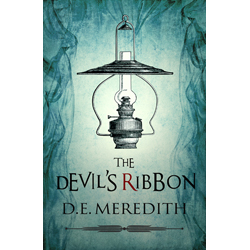 Published: 2013
Published: 2013
Author: D.E. Meredith
Captivating, relevant and exceptionally well-written

I’ve just embarked on the daunting task of writing a novel. It’s something I’ve wanted to do since I was a little girl and over the years I’ve started, written about 150 words, panicked and deserted my writing. Not only is the concern that my writing isn’t good enough but also the worry that I’m not being original enough. How often have reviewers (me included) criticised books for not giving the reader something new? It’s a minefield. Thankfully I’m not writing a detective story but I’m always in awe of authors who manage to create a crime novel which has that special something that makes it stand out from the crowd.
D.E. Meredith’s The Devil’s Ribbon is, thankfully, one such book. The second in her Hatton and Roumande mystery book follows Professor Adolphous Hatton and his assistant Albert Roumande as they employ new forensic techniques to assist the flamboyant Inspector Grey of Scotland Yard. In the middle of a cholera epidemic a series of murders, seemingly related to the tension between Ireland and England in the wake of the potato famine of 1845-1852. Six years later a number of murders bear the hallmark of Irish terrorists known as “Fenians” including the presence of a green ribbon on the victims’ bodies.
In a world of CSI fans and novels which include graphic depictions of post-mortems and forensic analyses it’s refreshing to be taken back to the very beginning of scientific investigations of crimes. Meredith has clearly done a great deal of research and has created a detailed and believable Victorian world. You can almost smell the stench of rotting, cholera infested bodies. What I was most impressed with however wasn’t the historical accuracy but the way that a story so brilliantly rooted in the Victorian era is so relevant to a modern reader.
The Irish sectarian tensions are unfortunately still a fact of life and reading this book in the middle of July meant that the story was strikingly relevant to what I was watching on the news. Meredith wasn’t afraid to portray the famine as not just a natural disaster but a genocide perpetrated upon the Irish by the British state and landowners who preferred to displace the population than offer the necessary support. The phrase that immediately attracted my attention was the evidence of one character who reports that “We shot dogs to keep them from the piled up bodies.” During the Rwandan genocide UN peacekeepers were unable to intervene to prevent the murders of 1 million people – all they could do was shoot dogs to prevent them from eating the remains of the dead. This is a book that brings the events of over a century and a half ago bang up to date.
I haven’t yet read Devoured, the first in the Hatton and Roumande series and perhaps that explains my lack of connection with the characters, particularly Albert Roumande. I was far more interested in the antagonist Inspector Grey, a fashion conscious, strong-armed detective with something of a mystery in his life. There’s definitely more scope for character development.
I’m less a quarter towards my target word count for my first draft. If I can write a book that is half as engaging, relevant and well-written as The Devil’s Ribbon I’ve be exceptionally pleased.
